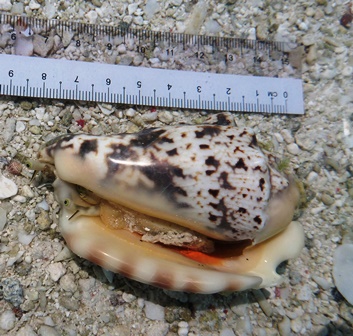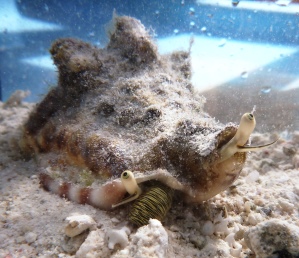Physical Description
In general, the shell of a Strombid is a hollow cone coiled around a central axis known as the columella. The opening of the cone is called the aperture through which the head and foot can be extended and retracted (Ruppert et al. 2004). Most genera and species from the family Strombidae are easily identified by the presence of a U-shaped notch on the edge of the outer lip near the anterior end. This “stromboid notch” is very deep and distinct in most species and serves as a “peep-hole” for the right eye of the animal (Kreipl & Poppe 1999). Another characteristic of the family includes the presence of colourful eyes, which protrude from under the shell and the foot with a differentiated propodium (Berg 1974). Shells of most Strombidae exhibit sexual dimorphism, usually consisting of a moderately larger size in female shells (Kreipl & Poppe 1999; Savazzi 1991). Strombid snails have long been a favourite of scientists and shell collectors because of their beautiful shells (Berg 1974).

Image of overturned Lentigo lentiginosus shell, showing general colouration and size of adult specimen (Photographer: Asia Armstrong).

Image of upright Lentigo lentiginosus specimen. Displays colourful eyes, with right eye protruding from the "stromboid notch" and extension of mobile proboscis (Photographer: Asia Armstrong).
The shell of Lentigo lentiginosus is thick and very heavy with a moderately high spire that has heavy knobs. The body whorl has 7-9 large square-shaped knobs at the shoulder, below which are 3-5 spiral rows of small rounded knobs. The columellar callus is thick anteriorly and smooth with an angular lobe at its base. The parietal wall is overlaid by a clear to translucent shiny glaze which sometimes extends up onto the spire as far as the apex. The outer lip is thick, crenulated and rather straight. The basic colour is cream to whitish with heavy speckling and mottlings of greenish grey to green-brown. The columellar callus is white, but often with a silvery or aluminium-like glaze, and the aperture is deep orange or salmon within, becoming creamy externally. The outer lip is tan with 5-6 indistinct light brown bars. It has been remarked that this particular species is consistent in its sculpture, colouration and size (Kreipl & Poppe 1999). The maximum shell length of this species is 100mm, but more commonly it grows up to 75 mm (Poutiers 1998).

Figure 1. Sketch of all external anatomical features of Lentigo lentiginosus (Image courtesy of Freshwater and Marine Image Bank). |